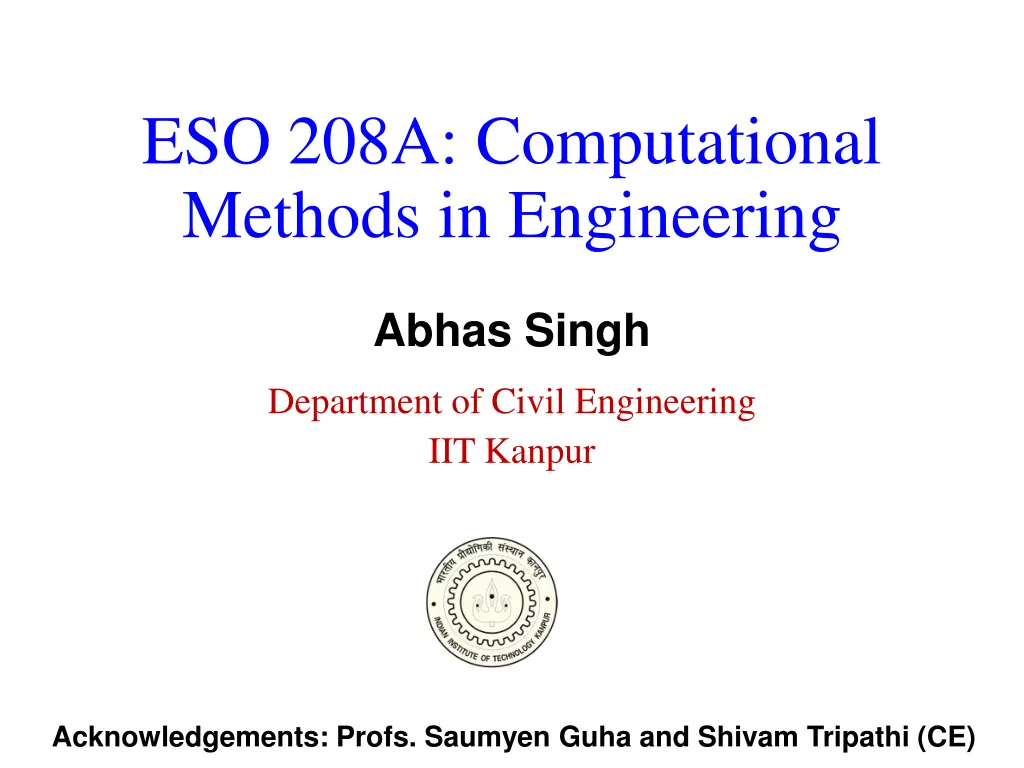
Computational Methods in Engineering: Overview and Applications
Learn about computational methods in engineering, including numerical problem formulations, key concepts, course details, and objectives. Discover the importance of algorithms in solving engineering challenges. Gain insights into the tools and techniques for computational analysis in various fields of engineering.
Download Presentation

Please find below an Image/Link to download the presentation.
The content on the website is provided AS IS for your information and personal use only. It may not be sold, licensed, or shared on other websites without obtaining consent from the author. If you encounter any issues during the download, it is possible that the publisher has removed the file from their server.
You are allowed to download the files provided on this website for personal or commercial use, subject to the condition that they are used lawfully. All files are the property of their respective owners.
The content on the website is provided AS IS for your information and personal use only. It may not be sold, licensed, or shared on other websites without obtaining consent from the author.
E N D
Presentation Transcript
ESO 208A: Computational Methods in Engineering Abhas Singh Department of Civil Engineering IIT Kanpur Acknowledgements: Profs. Saumyen Guha and Shivam Tripathi (CE)
Instructor: Abhas Singh Office: FB 306; Phone: 7665 e-mail: abhas@iitk.ac.in Course Website: home.iitk.ac.in/~abhas Tutors: Section Rm 1 2 3 4 5 6 7 8 9 Name Dept CE CE ChE Email arghya pradhi anamikak mkhalid soukat savarnya yrahul svsiva aafzal T103 Arghya Das T104 Pradhi Rajeev T105 Anamika Maurya T106 Mohammad Khalid ChE T107 Soukat Kumar Das CE T108 Abhishek Savarnya CE T109 Rahul Yadav T110 Siva Krishna T111 Arshad Afzal ME ChE ME
Text Book Guha, S. and Srivastava, R. Numerical Method for Engineering and Science, 3rdReprint 2015, Oxford University Press. Corrections to the 1stEdition (2010) and 2ndReprint (2012) are available here: http://home.iitk.ac.in/~rajeshs/ErrorsInFirstEditionNM.pdf Reference Books Chapra, S. C., and Canale, R. P. (2012). Numerical Methods for Engineers, 6th Edition, McGraw-Hill Education (India). Atkinson, K. E. (2008). An Introduction to Numerical Analysis, 2nd Edition, John Wiley & Sons.
Evaluation Final Exam: 40% Mid Sem Exam: 25% Quizzes (2 nos): 10% Programming Assignments: 10% Quizzes in Tutorials: 10 % Class Conduct (attendance, occasional class problems): 3% + 2% Mark your calendar for the Quiz Dates: Quiz I: Saturday, August 31, 2019, 10:00-10:40 am Quiz II: Saturday, November 2, 2019, 10:00-10:40 am Programming Assignments: MATLAB, C, Python
What are Computational Methods or Numerical Methods in Engineering? Formulation of mathematical problems in such a way that numerical answers can be computed using arithmetic operations in a computer Computer can only perform: + - / All kinds of problems can be solved: linear and non- linear systems of equations; approximation and interpolation of data; differentiation and integration, ODE, PDE
Objectives of the course Introduce you to computational methods and algorithms for the solution of engineering problems. Familiarize you to the algorithms behind the software packages so that you don t use them as black boxes. Expose you to the analysis of these algorithms so that, if needed, you can modify an existing algorithm or develop your own algorithm for the problem at hand.
Scope of the course Engineering Problems Physical laws/rules/ relationships Data Initial/Boundary conditions Mathematical Models Numerical Experimental Analytical Computational Resources Methods/Algorithms Programming Results
Recap What are computational methods? How they are used for solving engineering problems? The choice of computational method depends on the problem and intended use of the results. Example: Object falling from a building Formulation of mathematical model Choice of methods, convergence, convergence rate, errors [model, data, round-off and truncation], propagation of errors, stability & condition number. Number representation in computers Binary and decimal representation
What is Numerical Analysis ? Mathematical method to analyze whether the solution obtained from a Numerical Method represents the solution of the original mathematical problem ! A way to test for convergence! Convergence can be conditional or unconditional! A method cannot be used for a given problem without the analysis!
Example 1: Calculate the square root of 2. Mathematical Problem: x2 = 2, x = ? or Calculate the root of x2 2 = 0 2 is an irrational number. It cannot be computed using simple arithmetic operations! Generate a Cauchy sequence that converges to the square root of 2. Some Numerical Methods: 2 ?? ??+1=1 ?? ??+1=??+2 ??+1 ??+1= 2 2??+
Lets start all the methods with x0 = 1 and compute for five iterations: 2 ??: ?1= 2,?2= 1, ?3= 2,?4= 1,?5= 2 ??+1= ??+1=1 2 : ?1= 1.5,?2= 1.416667, ?3= 1.414216, 2??+ ?? ?4= 1.414214,?5= 1.414214 ??+1=??+2 ??+1: ?1= 1.5,?2= 1.4, ?3= 1.416667,?4= 1.413793,?5= 1.414286 Could we have predicted this without having to perform computations?
Test for convergence of sequence (MTH 101): Sequence: ??+1=1 2 2??+ ?? 2+ 2 = 2????+1 ?? Since the root is real, ?? 2 Therefore, ?? ??+1 2, the sequence is bounded! for ? 2, ?? ??+1= ?? 1 1 2 ?? Monotonically decreasing sequence and bounded:- a Cauchy sequence that converges to the lower bound 2 2 0 2+ 2 = 2????+1 2 2?? 2 2??+ = ?? 2 2 ?? 0, monotonically decreasing sequence!
Example 2: Solve the problem of the radioactive decay: ?? ??= ?? at ? = 0,? = ?0 True Solution: ? = ?0? ?? A Numerical Method: Euler Method (MTH 102) ??+1= ?? ? ?? where, h = time step t Consider two different elements with = 0.1 and 2.2 Let us compare true analytical solutions with the numerical solutions for h = t = 1 for these two elements.
= 0.1 /day, N0 = 106, h = t = 1, solution for 25 days There is some error but the numerical solution behaves like the true solution
= 2.2 /day, N0 = 106, h = t = 1, solution for 25 days The error can grow to make the solution unacceptable! Numerical analysis could have told me this, saving much time of programming and computation!
= 0.1 /day, N0 = 106, varying h, solution for 25 days Numerical analysis could have told me this, saving much time of programming and computation!
Take away message: Learning Numerical Analysis is as important as the Numerical Method for you to be able to apply the method for a given problem!! This is true irrespective of whether you are writing the program or using an existing program or package or software!
Errors and Error Analysis
Accuracy vs Precision Accuracy - How closely a measured/computed value agrees with the true value opposite sense: Inaccuracy (or bias) A systematic deviation from the actual value Precision (or reproducibility)- How closely individual computed/measured values agree with each other opposite sense: Imprecision (or uncertainty). Magnitude of scatter
Errors and Error Analysis Source: Chapra and Canale
Significant digits Number Significant digits Rule 228.18 5 All non-zero digits are significant 10.08 4 Zeros between non-zero digits are significant. Leading zeros are not significant. 0034.5 3 34.500 5 In a decimal number trailing zeros are significant. In a non-decimal number trailing zeros may or may not be significant No ambiguity in scientific notation 34500 3 or 4 or 5 3.450 x 104 4
Truncation error Source: Chapra and Canale
Define Error: True Value (a) = Approximate Value ? + Error ( ) Absolute Error: = ? ? Relative Error: ? = ? ? ? ? ?= Relative error is often expressed as (%) by multiplying (e) with 100. Absolute error can have sign as well as | . | If the error is computed with respect to the true value (if known), a prefix True is added. For an iterative process, the true value a is replaced with the previous iteration value and a prefix approximate is added. This is used for testing convergence of the iterative process.
Sources of Error in computation? Errors in the Input data: initial and boundary conditions, measured values of the parameters and constants in the model Round-off error: irrational numbers, product and division of two numbers, limited by the machine capability Truncation error: truncation of an infinite series, often arises in the design of the numerical method through approximation of the mathematical problem.
Integer Representation Binary Unsigned Signed bit Excess-p 2 s complement 000 0 0 -3 0 001 1 1 -2 1 010 2 2 -1 2 011 3 3 0 3 100 4 -0 1 -4 101 5 -1 2 -3 110 6 -2 3 -2 111 7 -3 4 -1






















